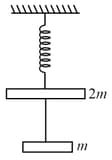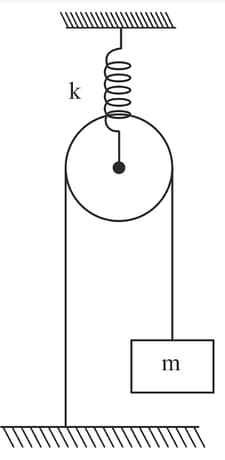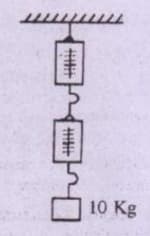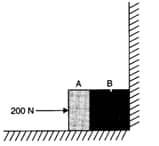Newton's Third Law of Motion
Newton's Third Law of Motion: Overview
This topic covers concepts such as Newton's Third Law of Motion and Action and Reaction.
Important Questions on Newton's Third Law of Motion
The string between blocks of mass and is massless and inextensible. The system is suspended by a massless spring as shown. If the string is cut find the magnitudes of accelerations of mass and (immediately after cutting)

A light spring balance hangs from the hook of the other light spring balance and a block of mass hangs from the former one. Then the true statement about the scale reading is –
Consider the situation shown in figure. Masses of both the block and the pulley is . Assume that string and spring are light, the elongation of the spring at equilibrium is

In a tug war contest, two man pull on a horizontal rope from opposite sides. The winner will be the man who
A block of mass is suspended through two light spring balances as shown

A car accelerates on a horizontal road due to the force exerted by
When a horse pulls a cart, the force that helps the horse to move forward is the force exerted by
A body of weight is suspended from the ceiling of a room through a chain of weight . The ceiling pulls the chain by a force
Can a single isolated force exist in nature? Explain your answer.
Why is it not possible to push a car from inside?
A man inside a freely falling box throws a heavy ball towards a side wall. The ball keeps on bouncing between the opposite walls of the box. We neglect air resistance and friction. Which of the following figures depict the motion of the centre of mass of the entire system (man, the ball and the box)?
Two bodies A and B of masses and in contact with each other rest on a table against a rigid wall as shown in the figure. The coefficient of friction between the bodies and the table is . A force of is applied horizontally to A. What are:
(a) the reaction of the partition?
(b) the action-reaction forces between A and B?
What happens when the wall is removed? Does the answer to (b) change, when the bodies are in motion? Ignore the difference between and .

Among the following statements, the one that is not true regarding the Newton’s third law of motion is,
A block of wood is kept on the table. The angle between the action of the block on the table and the reaction of the table on the block is
Action and reaction _____ act on the same body.
(Choose from: can/cannot)
Newton’s third law of motion can be derived as a second special case of Newton’s _____ law of motion.
Assertion: Newton's third law of motion is applicable only when bodies are in motion.
Reason: Newton's third law applies to only forces, e.g. gravitational, electricstatic forces etc.
Assertion: Nuclear force doesn't obey Newton's third law.
Reason: Nuclear force is not a central force.
Assertion: The third law of motion concludes that the forces occur in pairs of action and reaction.
Reason: The action force is more than the reaction force.
Assertion: Newton's third law is not applicable for nuclear forces.
Reason: Nuclear forces are short-ranged.
